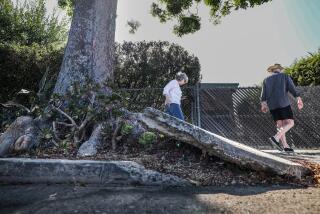Traffic Police Zero In on the Perilous Streets
- Share via
Dear Traffic Talk:
I don’t really understand the enforcement procedures of the Police Department.
In particular, I am curious about the intersection of Dickens Street at Sepulveda Boulevard in Sherman Oaks--actually three streets, including Saugus, meet at this point.
Traveling west on Dickens at Sepulveda there is a right-turn-only sign plus markings on the street reinforcing this restriction, yet it is ignored by drivers.
Sitting at an outdoor restaurant at the corner, I once counted 17 illegal left turns in one hour.
On another occasion I observed two motorcycle officers parked in the service station at the corner.
While waiting for a transgression to occur a block away at the intersection of Sepulveda and Ventura, they ignored two left turns within their line of sight at the intersection a block away.
If the infraction is to be ignored by police, why have the right-turn-only regulation at all?
Larry Paulson
Sherman Oaks
Dear Larry:
The answer comes from two officers from the Los Angeles Police Department’s Valley Traffic Division.
Officers Butch Stowell and Santiago Rosales said police try to enforce all of the traffic laws, but concentrate the majority of resources on the 20 or so major streets with the highest number of the most serious accidents.
Traffic reports are logged into a computer database, then the computer searches for streets with many reports of traffic accidents with major injuries.
Officers are then made aware of the streets.
Police said the streets can change for a number of reasons, including weather, street construction or people obeying the law because they know police are in the area, Rosales said.
He added that accidents are categorized by the type of injuries.
An A accident is one in which there is an injury that requires hospitalization.
B accidents have injuries such as lacerations, abrasions, scrapes or bruises, but injured parties are treated at the scene of the accident and released, Rosales said.
C accidents are those in which people are not sent to the hospital, but complain of injuries, such as neck or back pain, and are sent home.
K--which stands for “killed”--are accidents in which there is a fatality, he said.
Police officers concentrate most of their efforts on areas with the highest numbers of A and K accidents.
As for traffic enforcement, Valley police officers look for those violations most likely to cause accidents, Stowell said.
Violations that police watch for most frequently include speeding, driving while under the influence of drugs or alcohol, right-of-way violations such as illegal left turns at an intersection, pedestrian problems such as jaywalking, and red light or signal violations.
Police may let lesser moving violations go if they are concentrating on finding reckless drivers or speeders, Stowell said.
However, if a person sees a traffic problem in a certain area that officers are not responding to, or just wants to report a problem, the person may call the traffic complaint officer in the Valley Traffic Division at (818) 756-9203.
Traffic Talk appears Fridays in The Times Valley Edition. Readers may submit comments and questions about traffic in the Valley to Traffic Talk, Los Angeles Times, 20000 Prairie St., Chatsworth 91311. Include your name, address and phone number.
Letters may be edited, and no anonymous letters will be accepted.
To record your comments, call (818) 772-3303. Fax letters to (818) 772-3385. E-mail questions to valley@latimes.com
More to Read
Sign up for Essential California
The most important California stories and recommendations in your inbox every morning.
You may occasionally receive promotional content from the Los Angeles Times.













